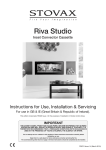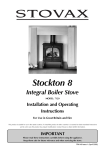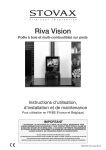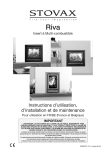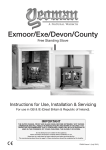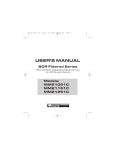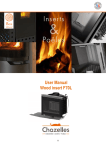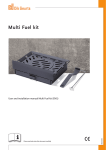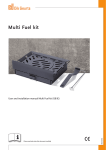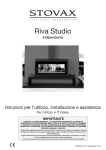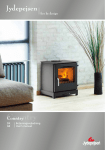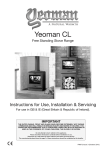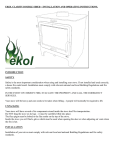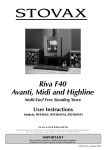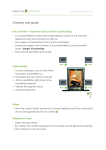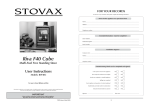Download Smoke Control Kit Installation and User Instructions
Transcript
225MF/525MF Smoke Control Kit Additional Installation and operating Instructions for use in Smoke Control Areas These instructions for fitting and operating the Smoke Control kit must be read in conjunction with the following Installation Instructions. Ref: Dovre 225 MF 03.27107.100 - 02/2013 Dovre 525 MF 03.27109.100 - 02-2013 PM1030 Issue 2 (February 2014) Use General Lighting 1 These instructions apply to the Dovre 225MF & 525MF products listed when fitted with a Smoke Control kit. 1 NOTE: These appliances have been independently tested to PD6434 and have been exempt from the controls that generally apply in smoke control areas hence are considered suitable for use in Smoke Control Area when burning wood and ONLY when fitted with the relevant Smoke Control kit detailed below. You can check whether the flue has enough draught by lighting a ball of paper above the baffle plate. A cold flue often does not have enough draught and consequently, some smoke may escape into the room instead of up the chimney. By lighting the fire in the way described here, you can avoid this problem. 2. Stack two layers of logs crosswise. Appliance 225 MF Smoke control kit Part No. 525 MF DV-225SCKIT DV-225SCKIT 2 To meet the Smoke Control requirement this appliance must be operated correctly in order to minimise the amount of smoke produced. 3 Burn dry wood only. 4 These instructions must be left with the user and kept with the original instructions which they now supersede. 225 MF 525 MF Recommended Log Size 300mm 400mm 3. Stack two layers of kindling crosswise on top of the logs. 4. Place a firelighter cube in the lower layer of kindling and light the cube according to the instructions on the packaging. 5. Close the door of the appliance and open the primary air inlet and the secondary air inlet of the appliance; see the diagrams over page. 6. Let this fire develop into a good blaze until there is glowing bed of charcoal. You can then add fuel and adjust the appliance, see the notes on refuelling the appliance. Recommended Fuels 1 Wood Logs: Burn only seasoned timber with a moisture content of less than 20%. To ensure this, allow cut wood to dry for 12 to 18 months. Poor quality timber: — Causes low combustion efficiency. — Produces harmful condensation. — Reduces effectiveness of the air control and life of the appliance. Do not burn construction timber, painted, impregnated / treated wood, manufactured board products or pallet wood. 2 Use Primary Air Control Open stacking Open stacking allows oxygen to easily reach every part of the fire. Compact stacking Secondary Air Control Compact stacking will make the wood burn slower as wood can only reach the outside of the fire. This will cause the fire to smoulder and produce smoke. Do not fill to more than 1/3 capacity. Refuelling on to a low fire bed Refuelling the Appliance 1 Open the Primary and Airwash air controls fully and burn for a few minutes before refuelling. Rake the embers evenly over the fire bed to establish a glowing firebed. If the fire bed is low add a small amount of kindling wood to help re-establish the fire and prevent excess smoke. If there is insufficient burning material in the firebed to light a new fuel charge, excessive smoke emission can occur. Refuelling must be carried out onto a sufficient quantity of glowing embers and ash that the new fuel charge will ignite in a reasonable period. If there are too few embers in the fire bed, add suitable kindling to prevent excessive smoke. Fuel overloading The maximum amount of fuel specified in this manual should not be exceeded, overloading can cause excess smoke. 3 Use 2 After refuelling: Burn the new logs at high output for 5 minutes before closing the Primary air control. Adjusting the burn rate using the Airwash air control. The secondary air slide controls the air flow for the glass and the vents in the back wall (2). The baffle plate has permanent vents (3) that allow for postcombustion. Advice Do not close the air controls until the fire is burning well. 3 Experience establishes settings to suit personal preferences. Never burn wood with an open door. 4 Do not burn large amounts of fuel with the Airwash control closed for long periods of time. This reduces the glass cleaning effect and causes tars and creosotes to build-up in the appliance and flue system and will produce excessive amounts of smoke. Regularly burn wood with intense roaring fires. 5 When in use, burning the appliance at high output for a short period also reduces tars and creosote. 6 When running the appliance: Refuel little and often for clean, efficient burning. 7 Wood burns best on a bed of ash. A bright and clean firebox indicates the appliance is burning well. Controlling the air If you frequently have low intensity fires, tar and creosote may be deposited in the chimney. Tar and creosote are highly combustible substances. Thicker layers of these substances might catch fire when the temperature in the chimney increases suddenly and steeply. Therefore it is necessary for the fire to regularly burn very intensely, so that layers of tar and creosote disappear. Low intensity fires also cause tar deposits on the stove window and door. When the outside temperature is not very low, it is better to burn wood intensely for a few hours instead of having a low intensity fire for a long period of time. Control the air supply with the secondary air inlet. The appliance has various features for the air control (see figure). The secondary air inlet not only supplies air to the fire but to the glass as well, so that it does not get dirty so quickly. Open the primary air inlet for the time being if the air supply by the secondary air inlet is inadequate or if you want to fan the fire. It is better to add a small amount of logs regularly than to add many logs at the same time. Extinguishing the fire 4 The primary air slide controls the air flow under the grille (1). Do not add fuel and just let the fire go out. If a fire is damped down by reducing the supply of air, harmful substances will be produced and released. Therefore, let the fire go out naturally. Keep an eye on the fire until it is gone out. If the fire has died completely, all air inlets can be closed. 6. Install the ashtray and close the appliance door. Comment: The Vintage 30 has no ashtray. Remove the ash with the aid of a shovel or use an “ash clean system” on the vacuum cleaner. Installation These instructions cover the fitting of the Smoke Control Kit Parts List Appliance 225MF Smoke control kit Part No. DV-225SCKIT 525MF 3. Remove the retaining nut at the bottom of the appliance and keep to hand as it will be required to fit the Smoke Control plate. DV-225SCKIT DV-225SCKIT contents: 1 x Smoke Control Plate Smoke Control Kit - Fitting Instructions 1 To fit the Smoke Control kit first remove the Outside Air Unit from the back of the appliance by removing the nuts and washers securing it in place. Outside Air Unit Retaining Nut 4. The Smoke Control kit comprises of a restrictor plate that stops the Sliders from closing completely. Nuts and washers 2. Lift off the Outside Air Unit to reveal the Primary and Airwash Sliders. Place carefully to one side. 5 Installation 5. Place the Smoke Control plate against the appliance. The hook at the top allows the plate to hang from the hole in between the Air Sliders. Hook 7. It is a requirement for the fitting of the Smoke Control kit to be obviously visible from the front of the appliance. An appliance modified for Smoke Control can be recognised in the following manner: All appliances with the Air Controls in the maximum OPEN position point straight down. Appliances that have not been fitted with the Smoke Control kit have Air Controls that are parallel to the ashlip when in the CLOSED position. 6. Secure the place with the retaining nut previously removed. Retaining Nut 6 The Smoke Control plate will now restrict the movement of the air sliders in order to comply with Smoke Control Regulations. Installation The Air Control on appliances modified for Smoke Control cannot shut down completely. 7 The Clean Air Act 1993 and Smoke Control Areas Under the Clean Air Act local authorities may declare the whole or part of the district of the authority to be a smoke control area. It is an offence to emit smoke from a chimney of a building, from a furnace or from any fixed boiler if located in a designated smoke control area. It is also an offence to acquire an “unauthorised fuel” for use within a smoke control area unless it is used in an “exempt” appliance (“exempted” from the controls which generally apply in the smoke control area). The Secretary of State for Environment, Food and Rural Affairs has powers under the Act to authorise smokeless fuels or exempt appliances for use in smoke control areas in England. In Scotland and Wales this power rests with Ministers in the devolved administrations for those countries. Separate legislation, the Clean Air (Northern Ireland) Order 1981, applies in Northern Ireland. Therefore it is a requirement that fuels burnt or obtained for use in smoke control areas have been “authorised” in Regulations and that appliances used to burn solid fuel in those areas (other than “authorised” fuels) have been exempted by an Order made and signed by the Secretary of State or Minister in the devolved administrations. Further information on the requirements of the Clean Air Act can be found here: http://smokecontrol.defra.gov.uk/ Your local authority is responsible for implementing the Clean Air Act 1993 including designation and supervision of smoke control areas and you can contact them for details of Clean Air Act requirements” The Dovre 225MF & 525MF have been recommended as suitable for use in smoke control areas when burning dry wood logs when suitable permanent stops have been fitted and when operated in accordance with the manufacturer’s instructions.








